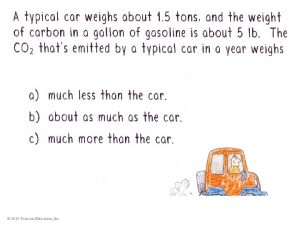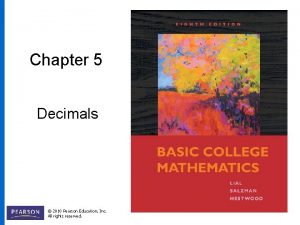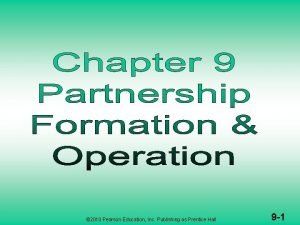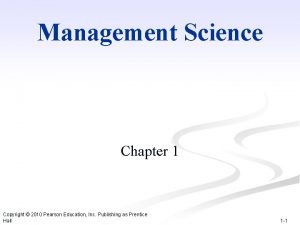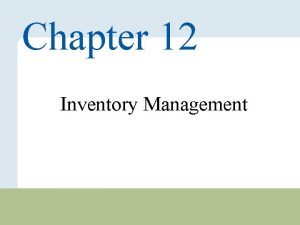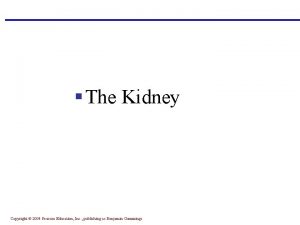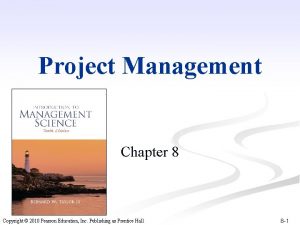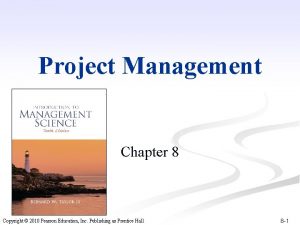Project Management Chapter 8 Copyright 2010 Pearson Education


















































































- Slides: 82

Project Management Chapter 8 Copyright © 2010 Pearson Education, Inc. Publishing as Prentice Hall 8 -1

Chapter Topics ■ The Elements of Project Management ■ CPM/PERT Networks ■ Probabilistic Activity Times ■ Microsoft Project ■ Project Crashing and Time-Cost Trade-Off ■ Formulating the CPM/PERT Network as a Linear Programming Model Copyright © 2010 Pearson Education, Inc. Publishing as Prentice Hall 8 -2

Overview ■ Network representation is useful for project analysis. ■ Networks show project activities are organized and are used to determine time duration of projects. ■ Network techniques used are: ▪ CPM (Critical Path Method) ▪ PERT (Project Evaluation and Review Technique) ■ Developed independently during late 1950’s. Copyright © 2010 Pearson Education, Inc. Publishing as Prentice Hall 8 -3

Elements of Project Management ■ Management is generally perceived as concerned with planning, organizing, and control of an ongoing process or activity. ■ Project Management is concerned with control of an activity for a relatively short period of time after which management effort ends. ■ Primary elements of Project Management to be discussed: § Project Planning § Project Team § Project Control Copyright © 2010 Pearson Education, Inc. Publishing as Prentice Hall 8 -4

Elements of Project Management Project Planning ■ Objectives ■ Project Scope ■ Contract Requirements ■ Schedules ■ Resources ■ Personnel ■ Control ■ Risk and Problem Analysis Copyright © 2010 Pearson Education, Inc. Publishing as Prentice Hall 8 -5

Elements of Project Management The Project Team ■ Project team typically consists of a group of individuals from various areas in an organization and often includes outside consultants. ■ Members of engineering staff often assigned to project work. ■ Project team may include workers. ■ Most important member of project team is the project manager. ■ Project manager is often under great pressure because of uncertainty inherent in project activities and possibility of failure. Potential rewards, however, can be substantial. ■ Project manager must be able to coordinate various skills of team members into a single focused effort. Copyright © 2010 Pearson Education, Inc. Publishing as Prentice Hall 8 -6

The Project Management Process Figure 8. 1 The project management Copyright © 2010 Pearson Education, Inc. Publishing as Prentice Hall 8 -7

Elements of Project Management Scope Statement ■ Document providing common understanding of project. ■ Justification describing the factors giving rise to need for project. ■ Expected results and what constitutes success. ■ List of necessary documents and planning reports. ■ Statement of work (SOW) - a planning document for individuals, team members, groups, departments, subcontractors and suppliers, describing what are required for successful completion on time. Copyright © 2010 Pearson Education, Inc. Publishing as Prentice Hall 8 -8

Elements of Project Management Work Breakdown Structure (WBS) (1 of 2) ■ WBS breaks down project into major components (modules). ■ Modules are further broken down into activities and, finally, into individual tasks. ■ Identifies activities, tasks, resource requirements and relationships between modules and activities. ■ Helps avoid duplication of effort. ■ Basis for project development, management , schedule, resources and modifications. ■ Approaches for WBS development: 1. Top down process 2. Brainstorm entire project Copyright © 2010 Pearson Education, Inc. Publishing as Prentice Hall 8 -9

Elements of Project Management Work Breakdown Structure (2 of 2) Figure 8. 2 WBS for Computer Order-processing System Project Copyright © 2010 Pearson Education, Inc. Publishing as Prentice Hall 8 -10

Elements of Project Management Responsibility Assignment Matrix (1 of 2) ■ Project manager assigns work elements to organizational units, departments, groups, individuals or subcontractors. ■ Uses an organizational breakdown structure (OBS). ■ OBS is a table or a chart showing which organizational units are responsible for work items. ■ OBS leads to the responsibility assignment matrix (RAM) ■ RAM shows who is responsible for doing the necessary work in the project Copyright © 2010 Pearson Education, Inc. Publishing as Prentice Hall 8 -11

Elements of Project Management Responsibility Assignment Matrix (2 of 2) Figure 8. 3 A responsibility assignment matrix Copyright © 2010 Pearson Education, Inc. Publishing as Prentice Hall 8 -12

Elements of Project Management Project Scheduling ■ Project Schedule evolves from planning documents, with focus on timely completion. ■ Critical element in project management – source of most conflicts and problems. ■ Schedule development steps: 1. Define activities, 2. Sequence activities, 3. Estimate activity times, 4. Construct schedule. ■ Gantt chart and CPM/PERT techniques can be useful. ■ Computer software packages available, e. g. Microsoft Project. Copyright © 2010 Pearson Education, Inc. Publishing as Prentice Hall 8 -13

Elements of Project Management Gantt Chart (1 of 2) ■ Popular, traditional technique, also known as a bar chart developed by Henry Gantt (1914). ■ Direct precursor of CPM/PERT for monitoring work progress. ■ A visual display of project schedule showing activity start and finish times and where extra time is available. ■ Suitable for projects with few activities and precedence relationships. ■ Drawback: precedence relationships are not always discernible. Copyright © 2010 Pearson Education, Inc. Publishing as Prentice Hall 8 -14

Elements of Project Management Gantt Chart (2 of 2) Figure 8. 4 A Gantt chart Copyright © 2010 Pearson Education, Inc. Publishing as Prentice Hall 8 -15

Elements of Project Management Project Control ■ Process of ensuring progress toward successful completion. ■ Monitoring project to minimize deviations from project plan and schedule. ■ Corrective actions necessary if deviations occur. ■ Key elements of project control § Time management § Cost management § Performance management § Earned value analysis. Copyright © 2010 Pearson Education, Inc. Publishing as Prentice Hall 8 -16

The Project Network CPM/PERT Activity-on-Arc (AOA) Network ■ A branch reflects an activity of a project. ■ A node represents the beginning and end of activities, referred to as events. ■ Branches in the network indicate precedence relationships. ■ When an activity is completed at a node, it has been realized. Figure 8. 5 Copyright © 2010 Pearson Education, Inc. Publishing as Prentice Hall Nodes and 8 -17

The Project Network Concurrent Activities ■ Network aids in planning and scheduling. ■ Time duration of activities shown on branches. ■ Activities can occur at the same time (concurrently). ■ A dummy activity shows a precedence relationship but reflects no passage of time. ■ Two or more activities cannot share the same start and end nodes. Figure 8. 7 A Dummy Activity Copyright © 2010 Pearson Education, Inc. Publishing as Prentice Hall 8 -18

The Project Network House Building Project Data No. Activity Predecessor Duration (Months) 1. Design house and obtain financing - 3 2. Lay foundation 1 2 3. Order Materials 1 1 4. Build house 2, 3 3 5. Select paint 2, 3 1 5 1 4, 6 1 6. Select carpet 7. Finish work Copyright © 2010 Pearson Education, Inc. Publishing as Prentice Hall 8 -19

The Project Network AOA Network for House Building Project Figure 8. 6 Expanded Network for Building a House Showing Concurrent Copyright © 2010 Pearson Education, Inc. Publishing as Prentice Activities Hall 8 -20

The Project Network AON Network for House Building Project Activity-on-Node (AON) Network § A node represents an activity, with its label and time shown on the node § The branches show the precedence relationships § Convention used in Microsoft Project software Figure 8. 8 Copyright © 2010 Pearson Education, Inc. Publishing as Prentice Hall 8 -21

The Project Network Paths Through a Network Path A B C D Events 1 2 4 7 1 2 5 6 7 1 3 4 7 1 3 5 6 7 Table 8. 1 Paths Through the House-Building Network Copyright © 2010 Pearson Education, Inc. Publishing as Prentice Hall 8 -22

The Project Network The Critical Path The critical path is the longest path through the network; the minimum time the network can be completed. From Figure 8. 8: Path A: 1 2 4 7 3 + 2 + 3 + 1 = 9 months Path B: 1 2 5 6 7 3 + 2 + 1 + 1= 8 months Path C: 1 3 4 7 3 + 1 + 3 + 1 = 8 months Path D: 1 3 5 6 7 3 + 1 + 1 = 7 months Copyright © 2010 Pearson Education, Inc. Publishing as Prentice Hall 8 -23

The Project Network Activity Start Times Figure 8. 9 Activity start time Copyright © 2010 Pearson Education, Inc. Publishing as Prentice Hall 8 -24

The Project Network Activity-on-Node Configuration Figure 8. 10 Activity-on-Node Copyright © 2010 Pearson Education, Inc. Publishing as Configuration Prentice Hall 8 -25

The Project Network Activity Scheduling : Earliest Times ■ ES is the earliest time an activity can start: ES = Maximum (EF) ■ EF is the earliest start time plus the activity time: EF = ES + t Figure 8. 11 Earliest activity start and finish times Copyright © 2010 Pearson Education, Inc. Publishing as Prentice Hall 8 -26

The Project Network Activity Scheduling : Latest Times ■ LS is the latest time an activity can start without delaying critical path time: LS = LF - t ■ LF is the latest finish time. LF = Minimum (LS) Figure 8. 12 Latest activity start and finish times Copyright © 2010 Pearson Education, Inc. Publishing as Prentice Hall 8 -27

The Project Network Activity Slack Time (1 of 2) n Slack is the amount of time an activity can be delayed without delaying the project: S = LS – ES = LF - EF n Slack Time exists for those activities not on the critical path for which the earliest and latest start times are not equal. n Shared Slack is slack available for a sequence of activities. Activity LS ES LF EF Slack, S Table *1 0 0 3 3 0 8. 2 *2 3 3 5 5 0 3 4 3 5 4 1 *4 5 5 8 8 0 5 6 5 7 6 1 6 7 6 8 7 1 *7 8 8 9 9 0 *Critical path Copyright © 2010 Pearson Education, Inc. Publishing as Prentice Hall 8 -28

The Project Network Activity Slack Time (2 of 2) Figure 8. 13 Activity slack Copyright © 2010 Pearson Education, Inc. Publishing as Prentice Hall 8 -29

Probabilistic Activity Times ■ Activity time estimates usually cannot be made with certainty. ■ PERT used for probabilistic activity times. ■ In PERT, three time estimates are used: most likely time (m), the optimistic time (a), and the pessimistic time (b). ■ These provide an estimate of the mean and variance of a beta distribution: variance: mean (expected time): Copyright © 2010 Pearson Education, Inc. Publishing as Prentice Hall 8 -30

Probabilistic Activity Times Example (1 of 3) Figure 8. 14 Network for Installation Order Processing Copyright © 2010 Pearson Education, Inc. Publishing as Prentice. System Hall 8 -31

Probabilistic Activity Times Example (2 of 3) Table 8. 3 Activity Time Estimates for Figure Copyright © 2010 Pearson Education, Inc. Publishing as Prentice Hall 8 -32

Probabilistic Activity Times Example (3 of 3) Figure 8. 15 Earliest and Latest Activity Times Copyright © 2010 Pearson Education, Inc. Publishing as Prentice Hall 8 -33

Probabilistic Activity Times Expected Project Time and Variance ■ Expected project time is the sum of the expected times of the critical path activities. ■ Project variance is the sum of the critical path activities’ variances ■ The expected project time is assumed to be normally distributed (based on central limit theorem). ■ In example, expected project time (tp) and variance (vp) interpreted as the mean ( ) and variance ( 2) of a normal distribution: = 25 weeks 2 = 62/9 = 6. 9 (weeks)2 Copyright © 2010 Pearson Education, Inc. Publishing as Prentice Hall 8 -34

Probability Analysis of a Project Network (1 of 2) ■ Using the normal distribution, probabilities are determined by computing the number of standard deviations (Z) a value is from the mean. ■ The Z value is used to find corresponding probability in Table A. 1, Appendix A. Copyright © 2010 Pearson Education, Inc. Publishing as Prentice Hall 8 -35

Probability Analysis of a Project Network (2 of 2) Figure 8. 16 Normal Distribution of Network Duration Copyright © 2010 Pearson Education, Inc. Publishing as Prentice Hall 8 -36

Probability Analysis of a Project Network Example 1 (1 of 2) What is the probability that the new order processing system will be ready by 30 weeks? µ = 25 weeks 2 = 6. 9 = 2. 63 weeks Z = (x- )/ = (30 -25)/2. 63 = 1. 90 Z value of 1. 90 corresponds to probability of. 4713 in Table A. 1, Appendix A. Probability of completing project in 30 weeks or less: (. 5000 +. 4713) =. 9713. Copyright © 2010 Pearson Education, Inc. Publishing as Prentice Hall 8 -37

Probability Analysis of a Project Network Example 1 (2 of 2) Figure 8. 17 Probability the Network Will Be Completed in 30 Weeks Copyright © 2010 Pearson Education, Inc. Publishing as Prentice or Less Hall 8 -38

Probability Analysis of a Project Network Example 2 (1 of 2) ■ A customer will trade elsewhere if the new ordering system is not working within 22 weeks. What is the probability that she will be retained? Z = (22 - 25)/2. 63 = -1. 14 ■ Z value of 1. 14 (ignore negative) corresponds to probability of. 3729 in Table A. 1, appendix A. ■ Probability that customer will be retained is. 1271 Copyright © 2010 Pearson Education, Inc. Publishing as Prentice Hall 8 -39

Probability Analysis of a Project Network Example 2 (2 of 2) Figure 8. 18 or Less Probability the Network Will Be Completed in 22 Weeks Copyright © 2010 Pearson Education, Inc. Publishing as Prentice Hall 8 -40

CPM/PERT Analysis with QM for Windows & Excel QM (1 of 2) Copyright © 2010 Pearson Education, Inc. Publishing as Prentice Hall 8 -41

CPM/PERT Analysis with QM for Windows & Excel QM (2 of 2) Copyright © 2010 Pearson Education, Inc. Publishing as Prentice Hall Exhibit 8. 2 8 -42

Analysis with Microsoft Project (1 of 13) Microsoft Project handles only AON networks. Exhibit 8. 3 Copyright © 2010 Pearson Education, Inc. Publishing as Prentice Hall 8 -43

Analysis with Microsoft Project (2 of 13) Exhibit 8. 4 Copyright © 2010 Pearson Education, Inc. Publishing as Prentice Hall 8 -44

Analysis with Microsoft Project (3 of 13) Exhibit 8. 5 Copyright © 2010 Pearson Education, Inc. Publishing as Prentice Hall 8 -45

Analysis with Microsoft Project (4 of 13) Copyright © 2010 Pearson Education, Inc. Publishing as Prentice Hall Exhibit 8. 6 8 -46

Analysis with Microsoft Project (5 of 13) Copyright © 2010 Pearson Education, Inc. Publishing as Prentice Hall Figure 8. 7 8 -47

Analysis with Microsoft Project (6 of 13) Copyright © 2010 Pearson Education, Inc. Publishing as Prentice Hall Figure 8. 8 8 -48

Analysis with Microsoft Project (7 of 13) Exhibit 8. 9 Copyright © 2010 Pearson Education, Inc. Publishing as Prentice Hall 8 -49

Analysis with Microsoft Project (8 of 13) Exhibit 8. 10 Copyright © 2010 Pearson Education, Inc. Publishing as Prentice Hall 8 -50

Analysis with Microsoft Project (9 of 13) Copyright © 2010 Pearson Education, Inc. Publishing as Prentice Hall Exhibit 8. 11 8 -51

Analysis with Microsoft Project (10 of 13) Copyright © 2010 Pearson Education, Inc. Publishing as Prentice Hall Figure 8. 12 8 -52

Analysis with Microsoft Project (11 of 13) Copyright © 2010 Pearson Education, Inc. Publishing as Prentice Hall Figure 8. 13 8 -53

Analysis with Microsoft Project (12 of 13) Exhibit 8. 14 Copyright © 2010 Pearson Education, Inc. Publishing as Prentice Hall 8 -54

Analysis with Microsoft Project (13 of 13) Copyright © 2010 Pearson Education, Inc. Publishing as Prentice Hall Exhibit 8. 15 8 -55

Project Crashing and Time-Cost Trade-Off Overview ■ Project duration can be reduced by assigning more resources to project activities. ■ However, doing this increases project cost. ■ Decision is based on analysis of trade-off between time and cost. ■ Project crashing is a method for shortening project duration by reducing one or more critical activities to a time less than normal activity time. Copyright © 2010 Pearson Education, Inc. Publishing as Prentice Hall 8 -56

Project Crashing and Time-Cost Trade-Off Example Problem (1 of 5) Figure 8. 19 The Project Network for Building a House Copyright © 2010 Pearson Education, Inc. Publishing as Prentice Hall 8 -57

Project Crashing and Time-Cost Trade-Off Example Problem (2 of 5) Crash cost & crash time have a linear relationship: Figure Copyright © 2010 Pearson Education, Inc. Publishing as Prentice 8. 20 Hall 8 -58

Project Crashing and Time-Cost Trade-Off Example Problem (3 of 5) Table 8. 4 Copyright © 2010 Pearson Education, Inc. Publishing as Prentice Hall 8 -59

Project Crashing and Time-Cost Trade-Off Example Problem (4 of 5) Figure 8. 21 Network with Normal Activity Times and Weekly Crashing Costs© 2010 Pearson Education, Inc. Publishing as Prentice Hall Copyright 8 -60

Project Crashing and Time-Cost Trade-Off Example Problem (5 of 5) As activities are crashed, the critical path may change and several paths may become critical. Figure 8. 22 Revised Network with Activity 1 Copyright © 2010 Pearson Education, Inc. Publishing as Prentice Hall 8 -61

Project Crashing and Time-Cost Trade-Off Project Crashing with QM for Windows Copyright © 2010 Pearson Education, Inc. Publishing as Prentice Hall Exhibit 8. 16 8 -62

Project Crashing and Time-Cost Trade-Off General Relationship of Time and Cost (1 of 2) ■ Project crashing costs and indirect costs have an inverse relationship. ■ Crashing costs are highest when the project is shortened. ■ Indirect costs increase as the project duration increases. ■ Optimal project time is at minimum point on the total cost curve. Copyright © 2010 Pearson Education, Inc. Publishing as Prentice Hall 8 -63

Project Crashing and Time-Cost Trade-Off General Relationship of Time and Cost (2 of 2) Copyright © 2010 Pearson Education, Inc. Publishing as Prentice Hall Figure 8. 23 The Time-Cost Trade-Off 8 -64

The CPM/PERT Network Formulating as a Linear Programming Model The objective is to minimize the project duration (critical path time General linear programming model with AOA convention: Minimize Z = i xi subject to: xj - xi tij for all activities i j x i, x j 0 Where: xi = earliest event time of node i xj = earliest event time of node j tij = time of activity i j Copyright © 2010 Pearson Education, Inc. Publishing as Prentice Hall 8 -65

The CPM/PERT Network Example Problem Formulation and Data (1 of 2) Figure 8. 24 Copyright © 2010 Pearson Education, Inc. Publishing as Prentice Hall 8 -66

The CPM/PERT Network Example Problem Formulation and Data (2 of 2) Minimize Z = x 1 + x 2 + x 3 + x 4 + x 5 + x 6 + x 7 subject to: x 2 - x 1 12 x 3 - x 2 8 x 4 - x 2 4 x 4 - x 3 0 x 5 - x 4 4 x 6 - x 4 12 x 6 - x 5 4 x 7 - x 6 4 xi, xj 0 Copyright © 2010 Pearson Education, Inc. Publishing as Prentice Hall 8 -67

The CPM/PERT Network Example Problem Solution with Excel (1 of 4) B 6: B 12 Copyright © 2010 Pearson Education, Inc. Publishing as Prentice Hall Exhibit 8 -68

The CPM/PERT Network Example Problem Solution with Excel (2 of 4) Exhibit 8. 18 Copyright © 2010 Pearson Education, Inc. Publishing as Prentice Hall 8 -69

The CPM/PERT Network Example Problem Solution with Excel (3 of 4) Copyright © 2010 Pearson Education, Inc. Publishing as Prentice Hall Exhibit 8. 19 8 -70

The CPM/PERT Network Example Problem Solution with Excel (4 of 4) Copyright © 2010 Pearson Education, Inc. Publishing as Prentice Hall Exhibit 8. 20 8 -71

Project Crashing with Linear Programming Example Problem – Model Formulation Minimize Z = $400 y 12 + 500 y 23 + 3000 y 24 + 200 y 45 + 7000 y 46 + 200 y 56 + 7000 y 67 subject to: y 12 5 y 12 + x 2 - x 1 12 x 7 30 y 23 3 y 23 + x 3 - x 2 8 xi, yij ≥ 0 y 24 1 y 24 + x 4 - x 2 4 Objective is to y 34 0 y 34 + x 4 - x 3 0 minimize the y 45 3 y 45 + x 5 - x 4 4 cost of y 46 3 y 46 + x 6 - x 4 12 crashing y 56 3 y 56 + x 6 - x 5 4 y 67 1 x 67 + x 7 - x 6 4 xi = earliest event time of node I xj = earliest event time of node j yij = amount of time by which activity i j is crashed Copyright © 2010 Pearson Education, Inc. Publishing as Prentice Hall 8 -72

Project Crashing with Linear Programming Excel Solution (1 of 3) Copyright © 2010 Pearson Education, Inc. Publishing as Prentice Hall Exhibit 8 -73

Project Crashing with Linear Programming Excel Solution (2 of 3) Copyright © 2010 Pearson Education, Inc. Publishing as Prentice Hall Exhibit 8. 22 8 -74

Project Crashing with Linear Programming Excel Solution (3 of 3) Copyright © 2010 Pearson Education, Inc. Publishing as Prentice Hall Exhibit 8. 23 8 -75

Example Problem Statement and Data (1 of 2) Given this network and the data on the following slide, determine the expected project completion time and variance, and the probability that the project will be completed in 28 days or less. Copyright © 2010 Pearson Education, Inc. Publishing as Prentice Hall 8 -76

Example Problem Statement and Data (2 of 2) Copyright © 2010 Pearson Education, Inc. Publishing as Prentice Hall 8 -77

Example Problem Solution (1 of 4) Step 1: Compute the expected activity times and variances. Copyright © 2010 Pearson Education, Inc. Publishing as Prentice Hall 8 -78

Example Problem Solution (2 of 4) Step 2: Determine the earliest and latest activity times & slacks Copyright © 2010 Pearson Education, Inc. Publishing as Prentice Hall 8 -79

Example Problem Solution (3 of 4) Step 3: Identify the critical path and compute expected completion time and variance. § Critical path (activities with no slack): 1 3 5 7 § Expected project completion time: tp = 9+5+6+4 = 24 days § Variance: vp = 4 + 4/9 + 1/9 = 5 (days)2 Copyright © 2010 Pearson Education, Inc. Publishing as Prentice Hall 8 -80

Example Problem Solution (4 of 4) Step 4: Determine the Probability That the Project Will be Completed in 28 days or less (µ = 24, = 5) Z = (x - )/ = (28 -24)/ 5 = 1. 79 Corresponding probability from Table A. 1, Appendix A, is. 4633 and P(x 28) =. 4633 +. 5 =. 9633. Copyright © 2010 Pearson Education, Inc. Publishing as Prentice Hall 8 -81

Copyright © 2010 Pearson Education, Inc. Publishing as Prentice Hall 8 -82
 2010 pearson education inc
2010 pearson education inc Copyright 2010 pearson education inc
Copyright 2010 pearson education inc Copyright 2010 pearson education inc
Copyright 2010 pearson education inc Copyright 2010 pearson education inc
Copyright 2010 pearson education inc Copyright 2010 pearson education inc
Copyright 2010 pearson education inc Copyright 2010 pearson education inc
Copyright 2010 pearson education inc 2010 pearson education inc
2010 pearson education inc Copyright 2010 pearson education inc
Copyright 2010 pearson education inc Composition copyright example
Composition copyright example Copyright 2010 pearson education inc
Copyright 2010 pearson education inc 2017 pearson education ltd
2017 pearson education ltd Copyright by pearson education inc. answers
Copyright by pearson education inc. answers 2009 pearson education inc
2009 pearson education inc Copyright pearson education inc
Copyright pearson education inc 2014 pearson education inc
2014 pearson education inc Copyright by pearson education inc. answers
Copyright by pearson education inc. answers Copyright 2003 pearson education inc
Copyright 2003 pearson education inc Copyright 2009 pearson education inc
Copyright 2009 pearson education inc Copyright pearson education inc
Copyright pearson education inc Copyright 2009 pearson education inc
Copyright 2009 pearson education inc 2009 pearson education inc
2009 pearson education inc 2009 pearson education inc
2009 pearson education inc 2009 pearson education inc
2009 pearson education inc Copyright pearson education inc
Copyright pearson education inc 2010 pearson education inc
2010 pearson education inc 2010 pearson education inc
2010 pearson education inc 2010 pearson education inc answers
2010 pearson education inc answers 2010 pearson education inc answers
2010 pearson education inc answers 2010 pearson education inc answers
2010 pearson education inc answers 2010 pearson education inc
2010 pearson education inc 2010 pearson education inc
2010 pearson education inc 2010 pearson education inc
2010 pearson education inc 2010 pearson education inc answers
2010 pearson education inc answers 2010 pearson education inc answers
2010 pearson education inc answers 2010 pearson education inc
2010 pearson education inc 2010 pearson education inc
2010 pearson education inc 2010 pearson education inc
2010 pearson education inc Two coins rotate on a turntable
Two coins rotate on a turntable 2010 pearson education inc
2010 pearson education inc 2010 pearson education inc
2010 pearson education inc 2010 pearson education inc answers
2010 pearson education inc answers 2010 pearson education inc
2010 pearson education inc 2010 pearson education inc
2010 pearson education inc 2010 pearson education inc
2010 pearson education inc 2010 pearson education inc answers
2010 pearson education inc answers Income statement example pearson
Income statement example pearson 2010 pearson education inc answers
2010 pearson education inc answers Pearson education inc. publishing as prentice hall
Pearson education inc. publishing as prentice hall Prentice hall publishing
Prentice hall publishing Pearson education inc publishing as pearson prentice hall
Pearson education inc publishing as pearson prentice hall Pearson education inc publishing as pearson prentice hall
Pearson education inc publishing as pearson prentice hall Pearson education inc publishing as pearson prentice hall
Pearson education inc publishing as pearson prentice hall Copyright 2008
Copyright 2008 C-929-a
C-929-a Copyright 2010
Copyright 2010 Copyright 2010
Copyright 2010 Nwoz
Nwoz Traditional vs modern project management
Traditional vs modern project management 2005 pearson prentice hall inc
2005 pearson prentice hall inc Pearson 2010
Pearson 2010 Educational pearson pearson times
Educational pearson pearson times Educational pearson pearson times
Educational pearson pearson times Education policy 1998 to 2010
Education policy 1998 to 2010 Education and training 2010
Education and training 2010 Education and training 2010
Education and training 2010 Ms project 2010 tutorial
Ms project 2010 tutorial Ms project 2003 tutorial
Ms project 2003 tutorial Curso basico de project 2010
Curso basico de project 2010 Microsoft project tutorial
Microsoft project tutorial The role of project management in achieving project success
The role of project management in achieving project success Iteration workflows in software project management
Iteration workflows in software project management Project cost duration graph
Project cost duration graph Introduction to project management kathy schwalbe
Introduction to project management kathy schwalbe What is strategic assessment in software project management
What is strategic assessment in software project management When conducting post project audits
When conducting post project audits Ms project agile
Ms project agile Type n terminations
Type n terminations Pearson education
Pearson education Pearson
Pearson Pearson education limited 2008
Pearson education limited 2008 Nitrogen cycle pearson education
Nitrogen cycle pearson education Pearson education limited 2005
Pearson education limited 2005 2017 pearson education ltd
2017 pearson education ltd


























